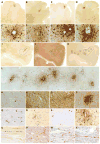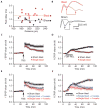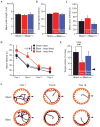Chronic traumatic encephalopathy in blast-exposed military veterans and a blast neurotrauma mouse model
- PMID: 22593173
- PMCID: PMC3739428
- DOI: 10.1126/scitranslmed.3003716
Chronic traumatic encephalopathy in blast-exposed military veterans and a blast neurotrauma mouse model
Abstract
Blast exposure is associated with traumatic brain injury (TBI), neuropsychiatric symptoms, and long-term cognitive disability. We examined a case series of postmortem brains from U.S. military veterans exposed to blast and/or concussive injury. We found evidence of chronic traumatic encephalopathy (CTE), a tau protein-linked neurodegenerative disease, that was similar to the CTE neuropathology observed in young amateur American football players and a professional wrestler with histories of concussive injuries. We developed a blast neurotrauma mouse model that recapitulated CTE-linked neuropathology in wild-type C57BL/6 mice 2 weeks after exposure to a single blast. Blast-exposed mice demonstrated phosphorylated tauopathy, myelinated axonopathy, microvasculopathy, chronic neuroinflammation, and neurodegeneration in the absence of macroscopic tissue damage or hemorrhage. Blast exposure induced persistent hippocampal-dependent learning and memory deficits that persisted for at least 1 month and correlated with impaired axonal conduction and defective activity-dependent long-term potentiation of synaptic transmission. Intracerebral pressure recordings demonstrated that shock waves traversed the mouse brain with minimal change and without thoracic contributions. Kinematic analysis revealed blast-induced head oscillation at accelerations sufficient to cause brain injury. Head immobilization during blast exposure prevented blast-induced learning and memory deficits. The contribution of blast wind to injurious head acceleration may be a primary injury mechanism leading to blast-related TBI and CTE. These results identify common pathogenic determinants leading to CTE in blast-exposed military veterans and head-injured athletes and additionally provide mechanistic evidence linking blast exposure to persistent impairments in neurophysiological function, learning, and memory.
Conflict of interest statement
Figures







Comment in
-
Traumatic brain injury: Brain trauma in military veterans.Nat Rev Neurosci. 2012 Jun 8;13(7):450. doi: 10.1038/nrn3277. Nat Rev Neurosci. 2012. PMID: 22678509 No abstract available.
-
Comment on "chronic traumatic encephalopathy in blast-exposed military veterans and a blast neurotrauma mouse model".Sci Transl Med. 2012 Oct 24;4(157):157le7; author reply 157lr5. doi: 10.1126/scitranslmed.3004595. Sci Transl Med. 2012. PMID: 23100624
-
Comment on "chronic traumatic encephalopathy in blast-exposed military veterans and a blast neurotrauma mouse model".Sci Transl Med. 2012 Oct 24;4(157):157le8; author reply 157lr5. doi: 10.1126/scitranslmed.3004403. Sci Transl Med. 2012. PMID: 23100625
References
-
- TRITON Report. Allen-Vanguard Threat Solutions; Shrivenham, UK: 2011.
-
- Hoge CW, McGurk D, Thomas JL, Cox AL, Engel CC, Castro CA. Mild traumatic brain injury in U.S. Soldiers returning from Iraq. N Engl J Med. 2008;358:453–463. - PubMed
-
- Wolf SJ, Bebarta VS, Bonnett CJ, Pons PT, Cantrill SV. Blast injuries. Lancet. 2009;374:405–415. - PubMed
-
- [accessed 24 February 2012];Independent Panel on the Safety and Security of United Nations Personnel in Iraq. http://www.un.org/News/dh/iraq/safety-security-un-personnel-iraq.pdf.
-
- Taber KH, Warden DL, Hurley RA. Blast-related traumatic brain injury: What is known? J Neuropsychiatry Clin Neurosci. 2006;18:141–145. - PubMed
Publication types
MeSH terms
Substances
Grants and funding
- NS044421/NS/NINDS NIH HHS/United States
- 5T32EB006359/EB/NIBIB NIH HHS/United States
- R01 GM075986/GM/NIGMS NIH HHS/United States
- R21 NS073679/NS/NINDS NIH HHS/United States
- P01 DK043881/DK/NIDDK NIH HHS/United States
- GM75986/GM/NIGMS NIH HHS/United States
- P30 AG013846/AG/NIA NIH HHS/United States
- R01 NS060872/NS/NINDS NIH HHS/United States
- T32 EB006359/EB/NIBIB NIH HHS/United States
- I01 CX001038/CX/CSRD VA/United States
- R01 NS078337/NS/NINDS NIH HHS/United States
- NS072966/NS/NINDS NIH HHS/United States
- P01DK043881/DK/NIDDK NIH HHS/United States
- R21 NS066108/NS/NINDS NIH HHS/United States
- F31 NS077796/NS/NINDS NIH HHS/United States
- R01 AI081990/AI/NIAID NIH HHS/United States
- RC4 NS072966/NS/NINDS NIH HHS/United States
- R56 NS044421/NS/NINDS NIH HHS/United States
- S10 RR026599/RR/NCRR NIH HHS/United States
- S10RR026599/RR/NCRR NIH HHS/United States
- R01 NS044421/NS/NINDS NIH HHS/United States
- R01NS078337/NS/NINDS NIH HHS/United States
- R01 ES020395/ES/NIEHS NIH HHS/United States
- F31NS077796/NS/NINDS NIH HHS/United States
- P30AG13846/AG/NIA NIH HHS/United States
LinkOut - more resources
Full Text Sources
Other Literature Sources
Medical
Research Materials

